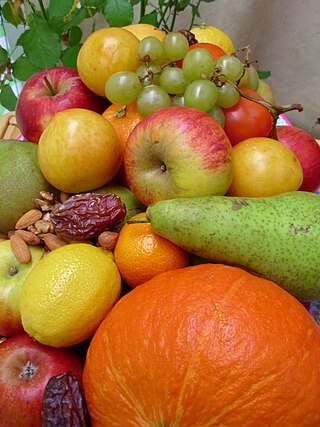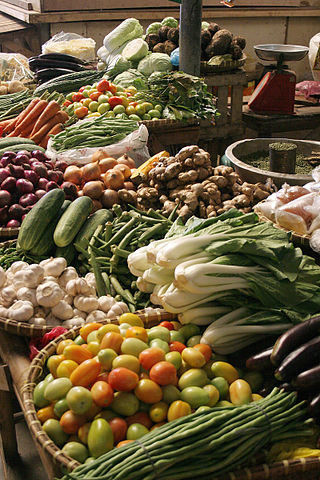
Fruitarianism is a diet that consists primarily of consuming fruits and possibly nuts and seeds, but without any animal products. Fruitarian diets are subject to criticism and health concerns.

Dietary fiber or roughage is the portion of plant-derived food that cannot be completely broken down by human digestive enzymes. Dietary fibers are diverse in chemical composition, and can be grouped generally by their solubility, viscosity, and fermentability, which affect how fibers are processed in the body. Dietary fiber has two main components: soluble fiber and insoluble fiber, which are components of plant-based foods, such as legumes, whole grains and cereals, vegetables, fruits, and nuts or seeds. A diet high in regular fiber consumption is generally associated with supporting health and lowering the risk of several diseases. Dietary fiber consists of non-starch polysaccharides and other plant components such as cellulose, resistant starch, resistant dextrins, inulin, lignins, chitins, pectins, beta-glucans, and oligosaccharides.

A food pyramid is a representation of the optimal number of servings to be eaten each day from each of the basic food groups. The first pyramid was published in Sweden in 1974. The 1992 pyramid introduced by the United States Department of Agriculture (USDA) was called the "Food Guide Pyramid" or "Eating Right Pyramid". It was updated in 2005 to "MyPyramid", and then it was replaced by "MyPlate" in 2011.

A plant-based diet is a diet consisting mostly or entirely of plant-based foods. Plant-based diets encompass a wide range of dietary patterns that contain low amounts of animal products and high amounts of fiber-rich plant products such as vegetables, fruits, whole grains, legumes, nuts and seeds. They do not need to be vegan or vegetarian, but are defined in terms of low frequency of animal food consumption.

A healthy diet is a diet that maintains or improves overall health. A healthy diet provides the body with essential nutrition: fluid, macronutrients such as protein, micronutrients such as vitamins, and adequate fibre and food energy.

5 A Day is any of various national campaigns in developed countries such as the United States, the United Kingdom, France, and Germany, to encourage the consumption of at least five portions of fruit and vegetables each day, following a recommendation by the World Health Organization that individuals consume "a minimum of 400g of fruit and vegetables per day ." A meta-analysis of the many studies of this issue was published in 2017 and found that consumption of double the minimum recommendation – 800g or ten a day – provided an increased protection against all forms of mortality. In some places, people are being encouraged to aim for not just five portions a day, but seven.

Vegetables are parts of plants that are consumed by humans or other animals as food. The original meaning is still commonly used and is applied to plants collectively to refer to all edible plant matter, including the flowers, fruits, stems, leaves, roots, and seeds. An alternative definition of the term is applied somewhat arbitrarily, often by culinary and cultural tradition. It may exclude foods derived from some plants that are fruits, flowers, nuts, and cereal grains, but include savoury fruits such as tomatoes and courgettes, flowers such as broccoli, and seeds such as pulses.

A smoothie is a beverage made by puréeing ingredients in a blender. A smoothie commonly has a liquid base, such as fruit juice or milk, yogurt or ice cream. Other ingredients may be added, including fruits, vegetables, non-dairy milk, crushed ice, whey powder or nutritional supplements.

Nathan Pritikin was an American inventor, engineer, nutritionist and longevity researcher. He promoted the Pritikin diet, a high-carbohydrate low-fat plant-based diet combined with regular aerobic exercise to prevent cardiovascular disease. The Pritikin diet emphasizes the consumption of legumes, whole grains, fresh fruit and vegetables and non-fat dairy products with small amounts of lean meat, fowl and fish.
Fruits & Veggies – More Matters is a national public health initiative from Produce for Better Health Foundation and Centers for Disease Control and Prevention (CDC) to increase the consumption of fruits and vegetables. This campaign, begun in 2007, took the place of the 5 A Day program. The shift was implemented in order to better communicate updated dietary guidelines, which recommended more than five servings of fruits and vegetables for some Americans.
Canadian health claims by Health Canada, the department of the Government of Canada responsible for national health, has allowed five scientifically verified disease risk reduction claims to be used on food labels and on food advertising. Other countries, including the United States and Great Britain, have approved similar health claims on food labels.

Juice is a drink made from the extraction or pressing of the natural liquid contained in fruit and vegetables. It can also refer to liquids that are flavored with concentrate or other biological food sources, such as meat or seafood, such as clam juice. Juice is commonly consumed as a beverage or used as an ingredient or flavoring in foods or other beverages, such as smoothies. Juice emerged as a popular beverage choice after the development of pasteurization methods enabled its preservation without using fermentation. The largest fruit juice consumers are New Zealand and Colombia. Fruit juice consumption on average increases with a country's income level.
The Fruit & Vegetable Prescription Program, also known as FVRx, is one of three of Wholesome Wave's programs. The program aims to provide under-served communities with fresh fruits and vegetables by allowing consumers to exchange healthcare provider-generated “prescriptions” for local fresh fruit and vegetables at participating, local farmers' markets.
Nutrition education is a combination of learning experiences designed to teach individuals or groups about the principles of a balanced diet, the importance of various nutrients, how to make healthy food choices, and how both dietary and exercise habits can affect overall well-being. It includes a combination of educational strategies, accompanied by environmental supports, designed to facilitate voluntary adoption of food choices and other nutrition-related behaviors conducive to well-being. Nutrition education is delivered through multiple venues and involves activities at the individual, community, and policy levels. Nutrition Education also critically looks at issues such as food security, food literacy, and food sustainability.
Wholesome Wave is an American nonprofit organization focused on nutrition and access to fresh food. Wholesome Wave operates two nutrition incentive programs, the Double Value Coupon Program and the Fruit & Vegetable Prescription Program, which tackle the issue of affordability for underserved consumers. The organization works with food hubs, retail outlets and convenience stores. Wholesome Wave's programs address the complex issues of food insecurity, farm viability, economic vitality of local communities, and diet-related diseases. Wholesome Wave was founded in 2007 by Michael Batterberry, Gus Schumacher and Michel Nischan.

MyPlate is the current nutrition guide published by the United States Department of Agriculture's Center for Nutrition Policy and Promotion, and serves as a recommendation based on the Dietary Guidelines for Americans. It replaced the USDA's MyPyramid guide on June 2, 2011, ending 19 years of USDA food pyramid diagrams. MyPlate is displayed on food packaging and used in nutrition education in the United States. The graphic depicts a place setting with a plate and glass divided into five food groups that are recommended parts of a healthy diet. This dietary recommendation combines an organized amount of fruits, vegetables, grains, protein, and dairy. It is designed as a guideline for Americans to base their plate around in order to make educated food choices. ChooseMyPlate.gov shows individuals the variety of these five subgroups based on their activity levels and personal characteristics.

The Farmers' Market Nutrition Program (FMNP) is a federal assistance program in the United States associated with the Special Supplemental Nutrition Program for Women, Infants and Children that provides fresh, unprepared, locally grown fruits and vegetables and nutrition education to WIC participants. Women, infants and children that have been certified to receive WIC program benefits or who are on a waiting list for WIC certification are eligible to participate in the FMNP.

The Partnership for a Healthier America (PHA) is a nonprofit organization created in conjunction with - but separate from - former First Lady Michelle Obama's Let's Move! effort in 2010. PHA works with the private sector to transform the food landscape in pursuit of health equity. Mrs. Obama currently serves as PHA's honorary chair, and alongside Higher Ground Productions, launched the Pass the Love w/ Waffles + Mochi campaign on March 10, 2021, with PHA to raise funds to aid in the distribution of 1 million meals to families in need around the country. Inspired by the Netflix series Waffles + Mochi, the campaign also raises awareness about food equity.
Federal responsibility for Canadian food labelling requirements is shared between two departments, Health Canada and the Canadian Food Inspection Agency (CFIA). All labelling information that is provided on food labels or in advertisements, as required by legislation, must be accurate, truthful and not misleading. Ingredient lists must accurately reflect the contents and their relative proportions in a food. Nutrition facts tables must accurately reflect the amount of a nutrient present in a food. Net quantity declarations must accurately reflect the amount of food in the package. Certain claims, such as those relating to nutrient content, organic, kosher, halal and certain disease-risk reduction claims, are subject to specific regulatory requirements in addition to the prohibitions in the various acts. For claims that are not subject to specific regulatory requirements, the Canadian Food Inspection Agency (CFIA) and/or Health Canada provide interpretive guidance that assist industry in compliance.

This is a list of food desert issues and solutions by country.













